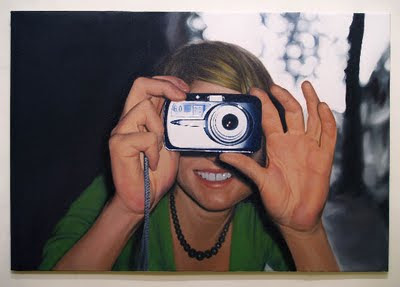The quantity of information present of the web, as well as its compartmentalization personified by wikipedia, allows for some instant cross-referencing. This is great, but something keeps creeping into my mind: Borges' tale about the map/territory relation as told by Baudrillard. I guess it is almost impossible to study urban design without stumbling at least half a dozen times across the simulacrum and hyperreality theories. It is really easy to get sucked into the thoughts of a long and interesting line of philosophers (from Plato to Frederic Jameson, Umberto Eco, Deleuze and Baudrillard himself) just like a teenager gets sucked into Nietzsche. And I must admit it is tasty food for though.
These subjects arose yet again while trying to come up with a back story for this post. At first I only wanted to divulge the work of Sergio Lopez. Not to say his work is hyperreal - it in fact departs into surrealism - but it reminded me of hyperrealism. But then I realized (no pun intended) I knew very little about this movement and so I went to wikipedia, of course.
Apparently Hyperrealism is a term used to describe an art movement and style developed in early 21st century, even though it was coined in 1973 to depict Photorealism - the genre which inspired it. Photorealism demonstrates how photography became assimilated into the art world. It is worth mentioning that realistic depictions or imagery have been around since antiquity. Artists have always tried to fool one's eye. It is interesting to note that the attempt to depict a subject in a realistic fashion continued at the same time the daguerreotype was invented and even after. However one cannot deny the implications photography had in the visual arts.
It's widely accepted that the Impressionism as a movement is inherently reactionary against the establishment of photography as a new medium. As with most inventions throughout the centuries, photography was seen as an undermining agent to the artist's reality mimicking abilities. Thus both portrait and landscape paintings seemed to lack in truth when compared to the "efficiency" and reliability" of photography [Levinson, Paul (1997) The Soft Edge; a Natural History and Future of the Information Revolution, Routledge, London and New York].
"Photography inspired Impressionists to capture the moment, not only in the fleeting lights of a landscape, but in the day-to-day lives of people", I read somewhere. This "inspiration" is not to be taken lightly as some of them, the Impressionists, actually based some of their work in original photographs.
Levinson [op. cit.] argues that photography did actually inspired artists to search for other original ways of expression. In this manner, instead of competing with the reality emulating proprerties of photography, artist turned the other way by focusing "on the one thing they could inevitably do better than the photograph – by further developing into an art form its very subjectivity in the conception of the image, the very subjectivity that photography eliminated". Better put, photography pushed painters into various exploration on the painting medium, like the colour that photography then lacked. [see also Sontag, Susan (1977) On Photography, Penguin, London]
It is with this same intention that Hyperrealism rose into being as it opposes the more litteral approach found in traditional 20th century photo-realistic paintings which insisted upon the imitation of photographic images, omitting or abstracting, by a process of sublimation, minute details so as to achieve an overall consistency - human emotion, political values, and narrative elements would all be omitted. Like Pop-Art, the artistic movement from which Photorealism originated, it had a precise, inflexible and mechanical quality to it, focusing mainly on mundane and everyday imagery.
On the contrary, Hyperrealism endows the photographic images which it uses as references with a more definitive and detailed quality by enriching it with narrative and emotive elements.
But even if hyperrealist renderings end up creating the illusion of a reality not present in the original photo - given its meticulous detail - one can not say they are surreal in nature because the illusion is a convincing depiction of (simulated) reality, or an illusion based on an simulation of reality embodied - or disembodied - in the digital photograph. In Baudrillard's words, ”the simulation of something which never really existed.”
This portrait called "Mark" was done by Charles Thomas "Chuck" Close between 1978 et 1979. Close reproduces photographic images by imitating the CMYK print in a big scale using a grid and painting each cell separately.
In stark contrast to the newer concurrent Photorealism with its continued avoidance of photographic anomalies. Hyperrealist painters at once simulate and improve upon precise photographic images to produce optically convincing visual illusions of reality, often in a social or cultural context.
Juan Francisco Casas uses the cell phone camera lo-fi photographs as references for creating images which don't conceal the anomalies present in this type of medium.
There isn't a great conclusion to all this. It just never ceases to amaze me how cyclic movements of resistance keep pushing evolution forward. I mean, sometimes it seams that art is just the hard way of doing things.












0 comments:
Note: only a member of this blog may post a comment.